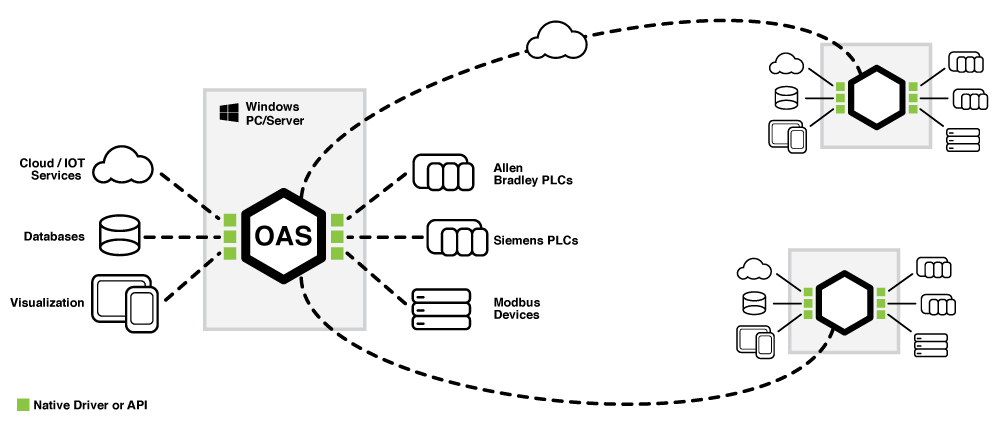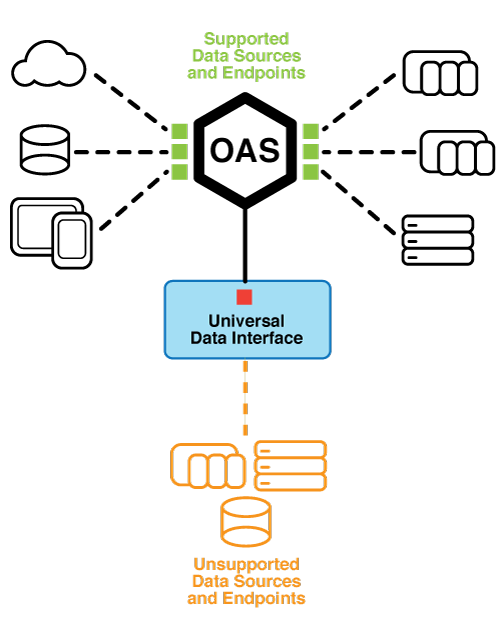 Automated Set-Up & Deployment
Automated Set-Up & Deployment
What if you could connect and read data from any device (Windows, Mac, Linux, Android and iOS) from anywhere in the world? What if you could spin up a device and it could automatically set up data points and start transmitting data as soon as it came online?
With Open Automation Software (OAS) Universal Driver Interface SDK, or UDI you can build a custom driver that automates configuration on startup. Once created, the driver can be deployed to multiple systems with no additional coding, simplifying new installations and dramatically reducing the cost of scaling your operations. The UDI also opens up new connectivity options by making it possible to connect to any other data source, device, or external API.
Eliminate human error, capture all your data and save time by automating processes previously manually entered across your enterprise.
The Open Automation Software Platform is already incredibly cost effective and flexible with unlimited connections and a decentralized network. While the platform supports MOST Data Sources and Endpoints, it does not support all….until now with the integration of the Universal Driver Interface.
Introducing The Universal Driver Interface SDK (UDI)
The OAS Platform has always been highly configurable and supported automated configuration through the use of the .NET Connector. But OAS has embraced the auto set up even further with the introduction of the Universal Driver Interface SDK. The UDI allows you to create communication drivers between devices, data, and APIs to integrate with the Open Automation Software IIoT Framework.
The Universal Driver Interface is also designed for cross-platform communications, it can be run remotely on different operating systems (PC’s – Linux, Mac OS, Android, iOS, even Raspberry Pi).
Simply run the Universal Driver Interface and it can automatically set itself up with the data model and individual data points you defined within the driver. The set-up of the communication points between different machinery is then automated.
How Does It Work?
In a typical platform communication, Open Automation Software communicates with controllers in a manufacturing plant, e.g .Allen Bradley, Siemens, Modbus and OPC servers and Clients.
This is all done on a Windows Server PC. Below, you can see a typical platform working on a windows server as well as other cloud-based technology communications.
The above diagram illustrates the existing Open Automation Software platform without the new driver interface. Each OAS Platform installation communicates with data sources and destinations using built-in drivers. Once data is within the OAS Platform, it can be shared with other instances of OAS over wide or local networks.
By implementing a driver using the UDI SDK, you can now open up many more opportunities to connect between devices, data, and APIs. A UDI implementation bridges the gap between previously unsupported or proprietary data sources and the OAS Platform.
Some of the advantages of the Universal Driver Interface are:
- flexible networking
- remote connectivity
- support for multiple operating systems
- one-click deployment
- no touch, automated set up
- one-click data logging
- speed – develop the code, run it and it’s done
- scalability – auto set up of multiple data points across manufacturing plants and remote locations eradicating human error and is far more time efficient.
Universal Driver Interface Set-Up
The Universal Driver Interface is built upon the .NET Standard 2.0 Framework, allowing it to be deployed and run on Windows, Mac, Linux, Android, iOS, and even Raspberry Pi platforms. (See all supported platforms)
It’s simple to implement into your existing Open Automation Software platform. The online working code examples are installed with the software.
Your Developer can then use the custom code supplied in VB.Net or C# to create your own custom communication drivers, data models and have those data points automatically set themselves up in the OAS Platform. Within the same code set, Developers can add default properties for the new set up to occur.
Your Developer can define your own data model, names, data types and parameters. Those Tags can then auto set up in the Open Automation Software server to begin the communication process. Then, when a user starts their device, it will automatically add a driver interface with a specific set of values across all data points.
How do you currently enter data into your Open Automation Software platform?
If it is plant-by-plant or process-by-process through manual entry, there is room for human error as well as inaccurate data being introduced into your systems.
With automated entry, you do take some time to figure out what you want the code to do, but it is well worth the effort. Auto setup eliminates human error by 100% based on the code routines and saves a lot of time since incremental deployments require minimal effort.
Driver set-up
Within the Open Automation Software, you can specify driver types and specific properties of the driver interface as well as manually set up Tags and other features. While the manual process works, it is not as effective or efficient, especially if you have many points of data to enter. Instead of multiple manual entry points, you can run the Universal Driver Interface which automatically tells the Open Automation Software its data model for the driver and data points and automatically adds them to the programming.
The Universal Driver Interface has been designed for cross platform communication. In other words, it allows you even greater flexibility to create your own basic code to communicate with the Open Automation Software platform and run on different operating systems. The Universal Driver Interface has a flexible networking and operating system to define your data models integrating them into the Open Automation Software platform.
Related articles/further reading:



